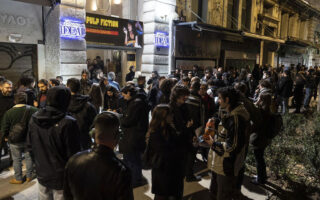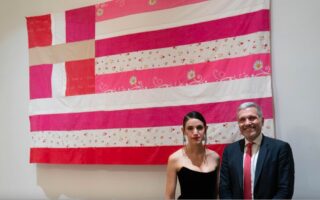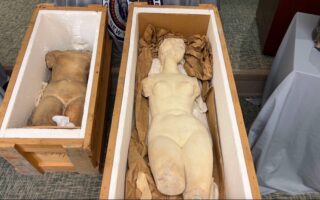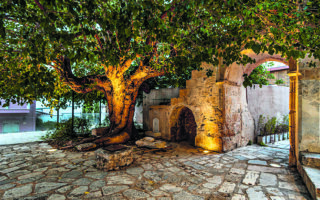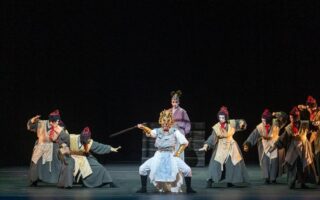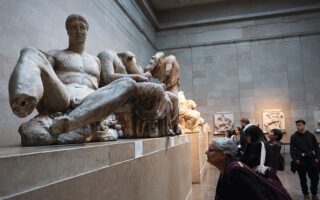Dimitris Pandermalis, visionary humility, tenacity, passion
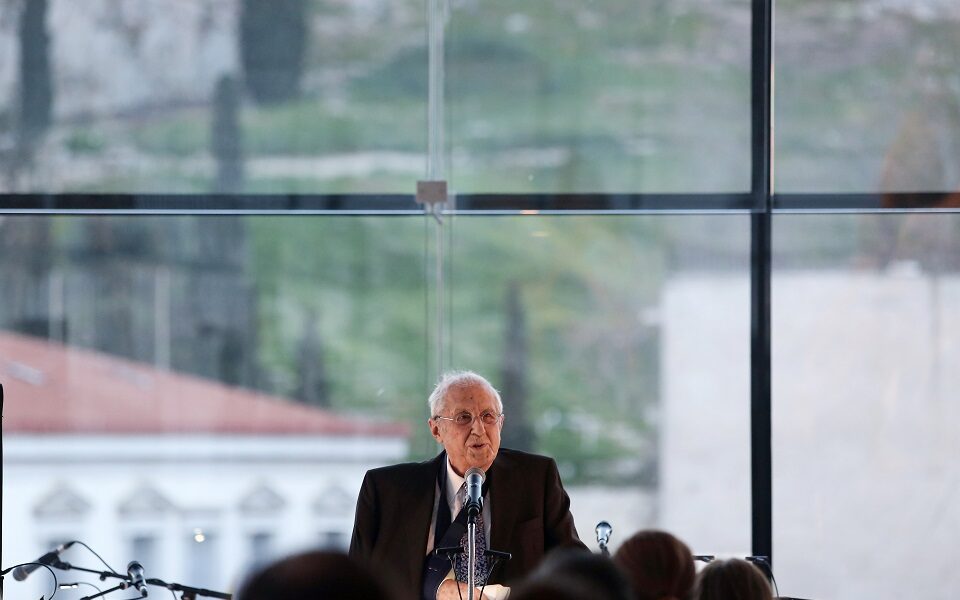
The streets and hills of Athens are ribbed with marble steps, ancient and modern, rising and dropping in the dawns and dusks of time. One recent addition to these monumental pathways is the set of paved stairs facing the performance area at the new Acropolis Museum that sits convivially below the Parthenon. On the evening of June 20, 2023, in celebration of the Museum’s 14th anniversary, hundreds of international guests gathered to pay tribute to the Museum’s visionary director, Dimitris Pandermalis, who passed away at the age of 82 on September 14 the year before. The summer night was splendid. Behind attendees, on the high Acropolis hill, the sacred Parthenon loomed, and in front even as darkness encroached, one could see the illuminated Parthenon frieze through the Museum’s glass-paneled walls.
Although Pandermalis was not there in person, his presence was deeply felt in an inspired program that featured the poetry of Nobel laureates George Seferis and Odysseas Elytis, and gifted poet and political activist Yiannis Ritsos, among others. The selections, rendered into song by Mikis Theodorakis, Manos Hadjidakis and Stavros Xarchakos, were performed by outstanding vocalists and the Youth Orchestra of Dion, a group of talented young musicians who traveled 200 kilometers to Athens to perform in honor of one of Dion’s “favorite sons.”
A pathfinding archaeologist at the helm of the archaeology and philosophy departments at Thessaloniki’s Aristotle University, Pandermalis directed Dion excavations at the foot of Mt Olympus, and was instrumental in building the nearby Dion Museum and in transforming the site into an inviting archaeological park. He was also the guiding force of the new Acropolis Museum in Athens. Greek Culture Minister Lina Mendoni called him the “heart and soul” of the Acropolis Museum. “Without him,” she said, “the museum would not exist.” Pandermalis often credited Aristotle University’s Professor Giorgos Bakalakis as a decisive influence on his own work. Bakalakis’ knowledge and insight paved the way for remarkable discoveries at Dion and at the Royal Tomb of King Philip in Vergina.
Pandermalis was born in the Agia Sofia neighborhood of Thessaloniki on May 5, 1940, a little less than a year before the start of World War II and the German occupation, brutal years of famine, poverty and atrocity. His younger sister Maria “Mika” Moisiadou tells a family favorite that took place in the aftermath of war about her brother, who, at the age of 9, went on a fishing expedition and brought home a bucket brim-full of fish, claiming it as his own. His mother, in disbelief, thinking someone else deserved credit, chided him on not telling the truth. So, to prove his skill as a fisherman – and his honesty – he went out again the following day and brought back another bucket so full that people stopped in amazement as he passed by. When he presented it to his mother, she recanted, convinced that he was not only a skilled fisherman but a very honest boy.
As a child, Pandermalis’ fascination with archaeology was sparked by his curiosity and imagination and was kindled by his father, a baker, and his mother, a homemaker. Both were interested in history and the classics and entertained him with stories. He became enamored with the idea that every step he took might yield a glimpse of the past.
In his work at Dion and Athens, he often spoke of the intense connection he felt when viewing a newly found artifact. He called the feeling “a third or fourth dimension,” something that took place beneath his immediate awareness. “You can communicate,” he said, “even if only rudimentarily with a soul that lived 2,500 years ago.”
Pandermalis’ ingenuity and style of leadership were evident when he called shepherds together to ask for their help in protecting the Dion site that encompassed acres of grazing land. He convinced them that the site was significant to them personally
An incident at Dion provides a poignant example. A gravesite was uncovered of a young man and woman embracing a child between them. As he stood at the site, in his mind’s eye, he envisioned a beloved family, perhaps brought down by disease, perhaps by war, and now at final rest. And, as if he was the husband and father, he turned abruptly toward his field crew and signaled to them to stop digging, and to leave the family at peace. Clearly, he felt some sort of intimate communication beyond the ordinary, a vivid reverberation from antiquity, a reminder of the frailty of human existence, the preciousness of human life.
Others have spoken of similar experiences. Stephen Guerriero, educational director of The Examined Life: Greek Studies in the Schools – an online graduate humanities and professional development program for K-12 educators – describes the feeling as “something almost surreal, and, at times, only a single degree of separation… a cutting through centuries of time.”
Inspired in childhood, Pandermalis devoted his life to archaeology and museum curatorial and educational endeavors. He held degrees from universities in Greece and Germany, wrote articles and books for adults and children, edited and produced films, gave lectures worldwide, and won countless awards. He was honored to accept an appointment as a national member of the Greek Parliament from September 1999 to March 2000. He said that sitting in Parliament meetings listening to veteran and fledgling politicians was an eye-opener for him and his knowledge grew about how to make winning cases for the ideas he wanted enacted.
His respect for the young as the ultimate beneficiaries and guarantors of a remarkable legacy led him to create educational centers in both Dion and Athens. When the Dion Museum was just getting off the ground, he introduced a workshop for young people to try their hand at working with such natural resources as clay and marble and where they gained greater understanding of the creative process. He was reverential in his respect for artists who transformed slabs of marble into such exquisite sculptures as the Caryatids, the Calf Bearer, and Nike unbuckling her sandal.
On entering the Acropolis Museum, children become captivated by animated figures from museum art flittering across a wall-sized screen. A second screen highlights cameo fragments from the collection. Click on one and the cameo becomes a larger-than-life image with information about exactly where it’s located in the museum. Three 3D models of the Acropolis hold a central place, and a short film, written and produced by Pandermalis, about the ofttimes overlooked caves on the Acropolis hillside. The museum boasts an impressive educational program that includes tours, games and visual materials, and such activities as chiseling marble and discovering plants and mythical gods in the art.
In his work, Pandermalis made use of the unique, hallowed light of Greece, its ability to sharpen one’s view of the thin, green stem of a chamomile plant emerging from a crack in a rock, and the tension reflected in the flared nostrils of a marble horse. Resplendent light became his greatest ally. In the Acropolis Museum, as the sun makes its way across the sky, the appearance of the Parthenon Sculptures change, highlighting at one point a crease in a kore’s peplos and, a few minutes later, a twist in her intricate braids. He never tired of sharing the museum’s incredible treasures with people from all walks of life, welcoming dignitaries, Hillary Clinton and Barack Obama among them, as well as visitors from isolated villages deep in the Greek countryside.
For over 20 years, Pandermalis’ Athens home was a modest fifth-floor apartment at 10 Skoufou Street where the morning sun highlights a balcony of plants and young olive trees, and floods the apartment with light. Wall-to-ceiling bookcases in every room housed his vast treasure of books relating to archaeology, philosophy, history, the classics and books about the impact of groundwater on excavating such sites as Dion. “The books were his tools,” commented his son, Stefanos Pandermalis, as his eyes scrolled the now-empty wall of shelves nine-feet high in the apartment’s main room. After his father’s death in September 2022, Stefanos gave the valuable collection to the new Acropolis Museum, where he anticipates they will occupy a library named in his father’s memory.
Out of one window, Pandermalis could catch a glimpse of the northeast corner of the Acropolis with a view of a Greek flag, ceremoniously raised at dawn and lowered at sunset, in honor of two teenage boys who, in the pitch of night, courageously tore down the Nazi flag and replaced it with the Greek flag in 1941 when the Nazis entered Athens. Pandermalis grew up with the story of their heroic deed and its symbolic call to freedom (“eleftheria”), one of the most animating and cherished Greek ideals.
Pandermalis and his only child, Stefanos, had a very close relationship. He created little makeshift books for Stefanos as a young boy to entice his interest in history and archaeology. As his health continued to fail, they spent hours together talking about everyday things as well as the veritable questions of life, and how to make the world a more humane place.
The quality that bound father and son was unequivocal trust. They opened their hearts to one another. Stefanos’ eyes are strikingly like his father’s, his intensity and all-embracing worldview quite like him, too. “When the end seemed imminent,” Stefanos said, “I brought him to the Dion home we both loved, where he died peacefully.” His love for his father is reflected in many ways, but visibly in the trees he planted that are taking root at their Dion homestead and the landscape he’s nourishing. “Until the day he died,” Stefanos said, “his mind was crystal-clear; he was acutely alert throughout his illness and our bond became even stronger. Our spirits drew even closer,” he said, “so that even to this day we walk together side-by-side.”
Humility, tenacity and passion were richly interwoven in the man. He projected calm even when confronted with countless formidable obstacles along the way. His mission was clear and he never wavered. Years of devoted work at Dion were his apprenticeship to creating a museum in Athens, worthy of the beauty it would house. His lifelong quest was fulfilled when the Acropolis Museum opened its doors on June 20, 2009. Five years later, London’s Sunday Times cited it as third in a list of the 50 most popular museums in the world. In 2019, the International Council of Museums (ICOM) named the Acropolis Museum one of the five most significant museums in the world.
Many stories speak to the affection and friendship that Pandermalis garnered in his lifetime. Eva Kanellis, family friend, university counselor, and tireless activist on behalf of the young, remembers the day Pandermalis welcomed a busload of elementary school students, including her daughter, to the Dion site, and how one busload became several. Pandermalis’ Aristotle University students led the tours, and each tour culminated in a question-and-answer session with Pandermalis. He chuckled as he commented to Kanellis that the young students asked sharper questions than his university students.
Aggeliki Gritsi, an Athens neighbor, also talked about his respect for the young. Often they met on their morning walk as they made their way through old-town Plaka – he, en route to the museum and she to drop off her children at the neighboring school. As they walked, they chatted informally about their children’s education and progress at the museum. On receiving Pandermalis’ invitation to visit the museum, before it had officially opened and even before the Greek prime minister had visited, the school community was overjoyed. “What a gift to students and teachers,” Gritsi said, “to have a private tour with the director who saw the museum as his home and wanted the children to consider it their home, too.”
Popular Greek-American writer, Gregory Maguire, recalled meeting Pandermalis at an informal children’s literature colloquy held in the Acropolis Museum. Maguire commented on “his genteel conviviality, his humility and lack of attitude that might betray a sense of importance or superiority…I was immensely proud to have had the chance to meet him.” At that same gathering, a question was posed about any fear he might have about leaving the sculptures free standing without protection, how easily one so inclined could do harm. His response was quick, “That’s not what educating children is about,” he said. “It is about inviting them to come a little closer.” He wanted the viewer to connect without barriers, and to find an object that touched them deeply and personally, a “third or fourth dimension” experience that would bring them back to the museum again and again.
Pandermalis’ ingenuity and style of leadership were evident when he called shepherds together to ask for their help in protecting the Dion site that encompassed acres of grazing land. He convinced them that the site was significant to them personally. “This is your land,” he said, “your property; it’s your history, and it’s yours to protect.” Imbued with a sense of personal responsibility, the shepherds rallied to his call and became volunteer overseers guarding their land from looters. He met with local residents as well, who joined in feeling a sense of pride in protecting Dion. They understood, too, that they were watching over the legacy of Greece. For each find turned over to the Dion Museum, the finder was awarded a highly prized certificate of honor.
He was determined to make museums and archaeological sites accessible to every spectrum of society. He had hoped to make admittance free for Greek citizens and he wanted all ages to feel at home. He believed deeply that Greece, a small country in the Mediterranean, was not just a speck on a map but a universal ideal. Kanellis commented that he opened eyes and changed perceptions of Greeks about archaeology, museum education, and the culture of his beloved country.
At the end of each day Pandermalis, wearing his trademark suspenders and scholar’s wire-framed glasses, walked the 1.6 kilometers home from the museum through old-town Plaka. Often, he would stop at Evgenia’s, a neighborhood restaurant, for a traditional home-cooked meal. Many such activities brought him pleasure: the startling appearance of a meadow amidst the stark mountains of Olympus, sipping a glass of tsipouro and talking with his dearest friend Nikos Zavandias, director of field staff in Dion, and broadening his own perspectives through mounting special exhibits such as the art of Qianlong (1711-1799), a Chinese emperor.
His meeting with Melina Mercouri, the Greek actress of “Never on Sunday” fame and a prominent political figure and culture minister (1981-1989), was auspicious. On a visit to Dion, she was taken by the scope of his work and his vision for a new Acropolis Museum, and became an ardent supporter. He was impressed by her concept of a “post-training” experience for teachers. Both prized education and advocated for free admittance to museums for Greek citizens. In addition, both were zealous activists for the return of the Parthenon Marbles to their home of origin. Pandermalis was not easily rattled by prickly questions posed by adversaries about the return of the marbles. “It’s a question of integrity,” he said. “As people have human rights, monuments have their own rights, especially monuments that are symbols.” Melina Mercouri’s visit was a dramatic call to continue their joint efforts to make Athens a cultural capital.
At the Acropolis Museum, a video greets visitors with the question, “What does the Acropolis Museum mean to you?” Answers represent people of all ages and each comment is the vision Dimitris Pandermalis inspired.
Six-year-old Despina said, “To me the Acropolis Museum means joy and fun.” Achilleas, also 6, agreed: “The Acropolis Museum is the museum of my heart.”
Natasha, 40, said: “The Acropolis Museum is the breath of Greece. Every day it absorbs the energy of its visitors. And spreads the light of the masterful Greek spirit to the whole world.”
“I love the feeling I have when I enter and meet the beautiful statues. The atmosphere has a magnificent aura…” commented Dina, 79.
Their comments about the museum could well be about Dimitris Pandermalis himself. From young children to teenagers, middle-aged adults and elders, thoughts are expressed. Perhaps it’s Chara, age 48, who sums it up in saying, “It’s the serenity and clarity…” Pandermalis saw art and archaeology as gateways to wisdom.
John Camp, professor emeritus, Randolph-Macon College, and long associated with the Agora excavations by the American School of Classical Studies in Athens, said: “Dimitris was a man of great vision and abilities… He held two major positions in his lifetime, either of which would alone have put him high in the ranks of the world of archaeology… The arrangement of space, light, displays and information are unparalleled, and Dimitris deserves most of the credit for creating and maintaining it all in his years as director. All Athenians and most of the world are indebted to him for his vision…”
Dion and the Acropolis Museum are the sites with which Dimitris Pandermalis’ name will be forever remembered. He will also be remembered as a man without pretense, a private man, passionate yet even-tempered, preferring to be out on site with field workers rather than sitting behind a desk, and repeatedly described as generous, friendly and kind, who won the hearts of the Greek people. He was a man of rare humility and equally rare nobility of spirit.
At 10 Skoufou a plaque will be placed simply stating, “For over twenty years, the home of Dimitris Pandermalis, the guiding force and first director of the new Acropolis Museum.”
* Barbara Harrison is founding director of The Examined Life: Greek Studies in the Schools. With many thanks to Stefanos Pandermalis and Eva Kanellis, and others who so generously shared their perceptions and stories: Professor John Camp, Aggeliki Gritsi, Stephen Guerriero, Gregory Maguire; and Margarita Charalabopoulou, MD, Dimitris Haralabopoulos, and Mara Kanari, Greek tour guide and independent scholar, for their research and insights. Credit, too, to others whose published interviews and brief commentary on Dimitris Pandermalis during his years of work, were helpful, in particular, Natasha Blatsiou, Mia Funk, and Steve Paikin. Also to Maria Georgopoulou, director, and her staff at the Gennadius Library of the American School of Classical Studies in Athens, where much of the article was written.
